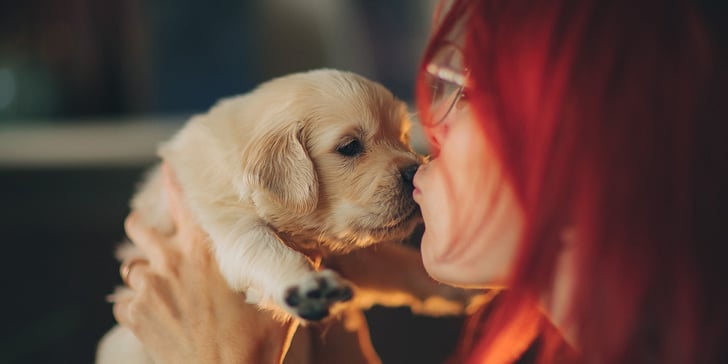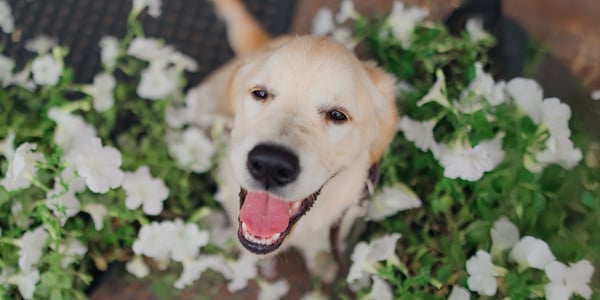Separation Anxiety in Golden Retrievers - Can They Be Left Alone?
Index:



Introduction
You brought home the waggiest tail on Earth and suddenly discovered that separation anxiety can turn a calm morning into a howling nightmare.
Your bouncing Golden Retriever puppy seems fine until they're left alone for the first coffee run, then the crying starts.
Carpets get shredded, neighbours complain, and you wonder if you made a mistake.
Hold on.
With the right plan, a bit of patience and expert tips, you can help your dog settle happily while you head out.
Key takeaways
Golden Retrievers form ultra-strong bonds and are prone to panic when suddenly isolated.
Early, gentle practice at short absences prevents bad habits and home damage.
Tools such as a safe crate and scent-based aids can calm worried minds.
Daily exercise plus brain games reduce stress before you walk out the door.
Video monitoring shows real-time progress and flags new worries quickly.
Medication is a safety net, not a first step. Training comes first.
Consistent routines keep their world predictable and their heartbeat steady.
Why Goldens struggle when home alone
That buttery golden coat hides a sensitive soul. Once bred to sit beside hunters all day, Goldens were selected for closeness.
When suddenly home alone, some flip into destructive behaviour. Think of it as an emotional fire alarm that will not switch off until you return.
The heritage factor
Because the breed was created for teamwork, many Goldens feel anxiety when left in silence. The dog cannot hunt, swim or cuddle you, so they invent a new job: redecorating.
Common triggers
Moving house, an owner’s new work shift pattern, or being left home alone after a holiday of 24/7 company can each light the fuse. Even a squeaky door that reminds the dog of departure may set teeth to their chew setting.
Fill the brain before you fill the bowl
Exercise is obvious, yet mental stimulation is the secret sauce. Scatter food in the garden or load a frozen Kong. When brains are busy, panic takes a back seat.
Professional help
If things escalate, a certified behaviourist offers a clear strategy. Expect customised plans, not quick fixes, and plenty of checkpoints. Remember, if you're a Waggel member, you get free behaviourist calls!



Puzzle toys vs other tools
Step-by-step plan for your pup
1. Introduce your pup to their safe zone first; being alone is lesson two.
2. Many English cream Golden Retrievers appear chilled compared to U.S and Canadian Retrievers, yet the same anxiety rules apply.
3. Use the radio, soft light and a food puzzle to mimic company.
4. When testing resilience, return before the whine begins. Success builds confidence and improves in stages.
Spotting trouble early
Watch for the classic demeanour of separation anxiety in dogs, such as pacing, whining, or door scratching. Learning the signs of separation anxiety helps you act before habits stick.
Maybe you see increased drooling or frantic digging; both signal growing anxiety when left alone.
Does gender matter?
A female Golden can panic just as much as a male. Hormones play a minor role, yet personality and history matter more.
Behaviour modification toolbox
Modern behaviour modification blends science, kindness and patience. The core treatment of separation anxiety involves teaching your dog that nothing bad happens when you leave the house.
Training schedule
Because Goldens are prone to separation anxiety, sessions must stay below the panic threshold. A timer is your best friend for managing separation anxiety in predictable steps.
You can leave an item like a plant pot on the floor in the home when you leave, then, as you arrive home, pick it up in front of the dog. This can help the dog associate the object with you leaving but always returning.



Case study: Buddy, 2-year-old Golden
Buddy chewed door frames, sofa legs, and howled for hours when left alone. Within eight weeks, his owners turned him from a panicky mess to a relaxed snoozer.
Key interventions:
Split long workdays with a walker or neighbour visit to dodge major changes in routine.
Daily scent games kept boredom low. This and puzzle games with treats.
High-value chews and things like yak milk chews, especially, can replace their favourite furniture legs.
Soothing sounds and a camera with speakers let the owners talk to the pet and reassure them.
When to call the vet
Dogs experiencing separation anxiety may need a medical check. Pain, thyroid issues or gut discomfort can masquerade as panic, so rule them out first with a professional.
A responsible breeder should also share the family history of fear issues. If the family has problems with separation, ask the breeder how they dealt with it and what the symptoms of the parents are.
Physical clues
Look for trembling, excess licking and other signs of anxiety. Your vet can view any video of your dog’s separation anxiety in order to grade the severity.
Why routine leads to calm
Skipping breakfast walks can lead to separation anxiety spiking. Exercise empties the worry tank, so your dog does not whine before you even pick up your keys.
These dogs have lots of energy to expend, so keep up with their regular routine, and you'll be thankful for it later.
Thirty minutes of regular exercise plus five minutes of sniff walks lowers cortisol. Remember, Goldens drool less when tired.
Add thirty minutes of combined exercise and mental stimulation on wet days using indoor games.



The four-minute exit drill
Silently gather bags, then leave your Golden Retriever for exactly four minutes. Return, praise calm, repeat. Tiny doses add up.
Scent therapy
A plug-in pheromone diffuser can help puppies and adults alike, gently helping your dog link alone time with relaxation.
Medication
Some vets may recommend short courses of trazodone or gabapentin, which can lower arousal, giving space for calm learning. Medication supports, never replaces, training though and should only be given on the strict instruction of a vet.
Why barking happens
The same tight bonds with their owners that make Goldens lovable can fuel panic. Windows invite watch duty, causing excessive barking at every passerby.
For tips on decoding woofs, see what dog barks mean.
Clingy behaviours vs healthy bonding
Being a bit clingy is normal in juveniles. The goal of dog training is to foster independence while keeping affection alive.



Tackling sound phobias
A thunder phobia can overlap with separation worries. Pair calm music with treats so the dog learns, “Storms mean snacks.”
Why Golden Retrievers are special
Yes, Golden Retrievers are known for smiling, but they still need guidance. They are an amazing family dog who loves every second they spend with you.
Just remember to always reward calm moments. Remind yourself that dogs are social animals first.
Your goal is a dog who is relaxed when alone.
Reading body language
If your dog waits near the door, licking their lips, she is not plotting an escape; they are likely worried.
Kennel or cosy corner?
An indoor kennel can feel safe if introduced with treats and never used as punishment. You should get your dog used to this in stages as young as possible.



Realistic expectations
Every dog differs. Some breeze through training in weeks, others take months. Keep notes, ask pros, and celebrate tiny wins.
Wrapping up and thinking ahead
With patience, smart routines, and a toolbox of science-backed tricks, your Golden can snooze peacefully while you tick off errands.
If you're a Golden Retriever parent and want to see how much it would cost to protect your pet, see our Golden Retriever insurance page for more info.
Waggel Pet Insurance
Need more help? You're in luck if you're a Waggel Pet Insurance member. Along with our excellent coverage, we offer access to a 24/7 online vet to answer all your sticky questions, especially if you need grooming assistance.
Not a member? Why not get a quote now and cover your furry friend for a range of illnesses, all while enjoying our amazing perks and rewards.
Want more like this?
Get updates from us with helpful info, advice, answers to frequently asked questions and much more.
Index:
- Introduction
- Why Goldens struggle when home alone
- Fill the brain before you fill the bowl
- Puzzle toys vs other tools
- Step-by-step plan for your pup
- Behaviour modification toolbox
- Case study: Buddy, 2-year-old Golden
- When to call the vet
- Why routine leads to calm
- The four-minute exit drill
- Why barking happens
- Clingy behaviours vs healthy bonding
- Tackling sound phobias
- Why Golden Retrievers are special
- Kennel or cosy corner?
- Realistic expectations
- Wrapping up and thinking ahead
Related posts:
Get your quote
Along with our excellent coverage, we offer access to a 24/7 online vet to answer all your sticky questions.





